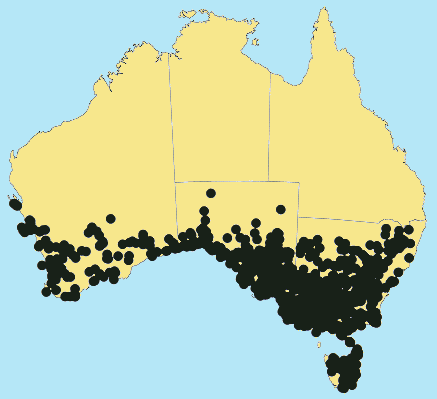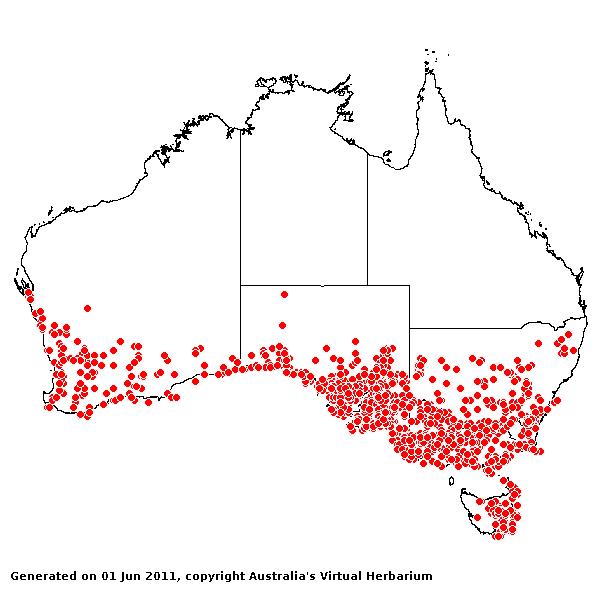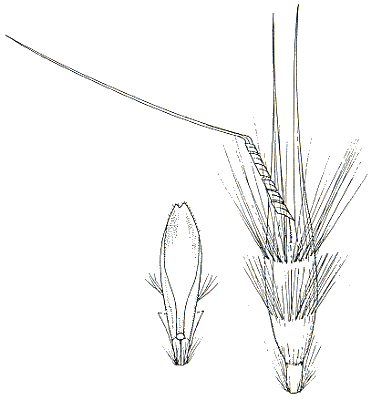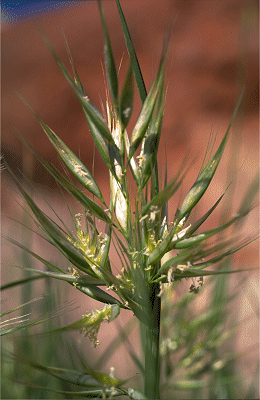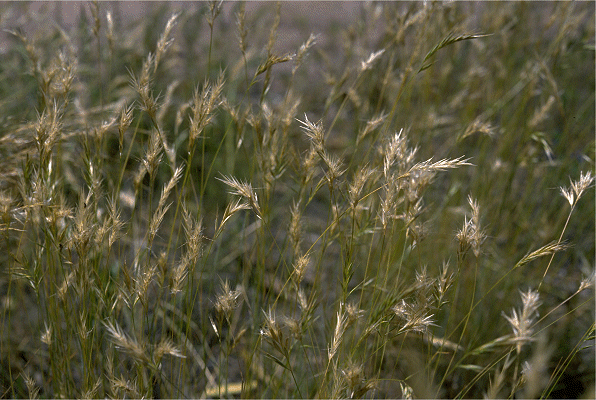Rytidosperma caespitosum
(Gaud.) Connor & Edgar. New Zealand J. Bot. 17: 325 (1979).
Classification. (GPWG 2001) : Subfamily
Danthonioideae. Tribe Danthonieae.
Basionym and/or
Replacement Name: Danthonia
caespitosa Gaudich., Voy. Uranie 4: 408 (1826).
Type of Basionym or
Protologue Information: HT: Guadichaud s.n., Australia: Western
Australia: Shark's Bay (P; IT: BM, K).
Recent synonyms: Notodanthonia caespitosa (Gaud.) Zotov, Austrodanthonia caespitosa
(Gaud.) H.P. Linder.
Key references
(books and floras): [1810]. R.Brown, Prodromus (177 as Danthonia
semiannularis), [1981] M.Lazarides in J.Jessop (ed)., Flora of Central
Australia (439 as Danthonia), [2002] D.Sharp & B.K.Simon, AusGrass,
Grasses of Australia, [2002] J.Wheeler, N.Marchant & M.Lewington, Flora
of the South West (401), [2006] J.Jessop, G.R.M.Dashorst, F.M.James, Grasses
of South Australia (286), [2008] S.W.L.Jacobs, R.D.B.Walley & D.J.B.Wheeler,
Grasses of New South Wales (142).
Illustrations:
[2005] K.Mallet (ed.), Flora of Australia 44B: Poaceae 3 (Fig.
10, K-L), [2006] J.Jessop, G.R.M.Dashorst, F.M.James, Grasses of South
Australia (288, Fig. 222), [2008]
S.W.L.Jacobs, R.D.B.Whalley & D.J.B.Wheeler, Grasses of New South Wales,
4th edn (142).
Derivation: L.
caespes, grass that has been cut; -osa, abundance. Habit tufted.
Habit.
Perennial. Culms erect, 13–90 cm tall, 2–4 -noded. Mid-culm nodes glabrous.
Leaf-sheaths hairy. Ligule a fringe of hairs. Leaf-blades flat or involute,
15–35 cm long, 1–2(–4) mm wide. Leaf-blade surface glabrous or indumented.
Inflorescence.
Inflorescence solid, a panicle. Panicle linear or lanceolate, 3–13 cm long.
Spikelets.
Spikelets pedicelled. Fertile spikelets many flowered, with at least 2 fertile
florets (6–9), comprising 6–9 fertile floret(s), with diminished florets at the
apex, cuneate, laterally compressed, 12.5–24 mm long.
Glumes. Glumes
similar, thinner than fertile lemma, shiny. Lower glume lanceolate, membranous,
without keels, 5–7 -nerved. Upper glume lanceolate, 14–24 mm long, membranous,
without keels, 5–7 -nerved.
Florets.
Fertile lemma 2.3–5 mm long, without keel, 9 -nerved. Lemma apex lobed, awned,
3 -awned. Median (principal) awn from a sinus, 15–25 mm long overall, with a
twisted column. Column 2–7 mm long. Lateral lemma awns present. Palea apex
dentate. Lodicules present. Anthers 3. Grain 1.2–2 mm long.
Continental
Distribution: Australasia.
Australian
Distribution: Western Australia, South Australia, New South Wales,
Victoria, Tasmania.
Western Australia:
Eucla, Irwin, Drummond, Dale, Menzies, Eyre, Roe, Avon, Coolgardie. South
Australia: North-western, Nullabor, Gairdner-Torrens Basin, Flinders
Ranges, Eastern, Eyre Peninsula, Northern Lofty, Murray, Yorke Peninsula,
Southern Lofty, Kangaroo Island, South-eastern. New South Wales: Central
Coast, Northern Tablelands, Southern Tablelands, North-Western Slopes,
Central-Western Slopes, South-Western Slopes, North-Western Plains,
South-Western Plains, North Far Western Plains, South Far Western Plains. Victoria:
East Gippsland, Eastern Highlands, Gippsland Highlands, Gippsland Plain,
Grampians, Lowan Mallee, Midlands, Murray Mallee, Otway Plain, Otway Range,
Wilsons Promontory, Riverina, Snowfields, Volcanic Plain, Wannon, Wimmera. Tasmania:
Furneaux Group, North West, North East, West Coast, Central Highlands,
Midlands, Ben Lomond, East Coast, South West.
Notes. This
species may be confused with several other species: a) R. erianthum,
from which it differs by the narrower, oblong lemmas, by the glabrous to
scaberulous pedicels and the longer paleas; b) R. setaceum, from which
it may be separated by the longer glumes and lemmas, the relatively longer
palea, more villous leaves, the sparser inflorescences, and the lemma
indumentum of usually not overlapping rows; c) R. duttonianum, from
which it may be distinguished by the pale green to grey lemma backs, the
inflorescence branches not being longer than the pedicels.
Widespread
in Australia south of the 32nd latitude, generally restricted to sunny
habitats, from grassland to desert to heathlands. Flowers Sep. to Nov.
